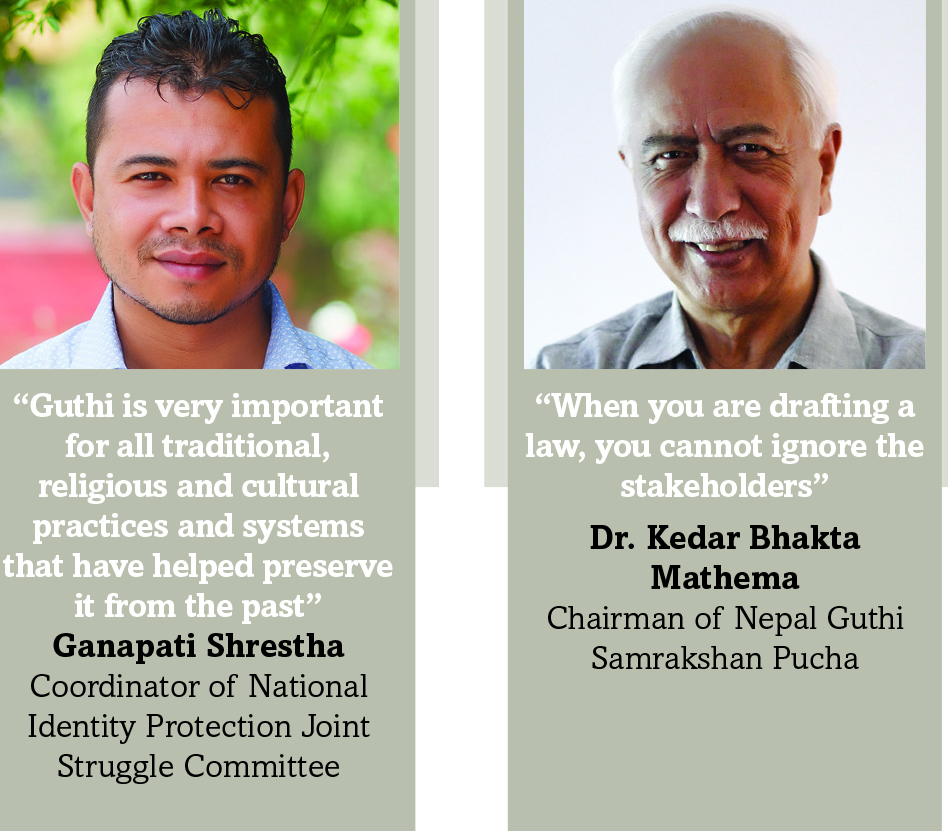
Photo : Samartha Ranjit
When you consider the timeline of what has transpired in the past few weeks, one would get the basic idea about what Guthi means for cultural identity and what the controversial Guthi Bill attempted to stifle. The government’s attempt to regulate both public and private Guthi and the events that occurred consequently, if not anything, has brought a period of reflection for all parties involved, the Newar community, the Nepali people and of course the government.
Guthi has always been a strong symbol of culture and community among the Newar population. The culture evidently has lost its glorious history but just over a month ago, national dailies published a picture of man being hosed down by the police in what was supposed to be a peaceful protest against the ‘Guthi Bill’ at Maitighar Mandala in the capital. The brutality alone sparked mass outrage. Days following the incident, individuals from various communities and walks of life stepped up in an attempt to save and preserve this age-old tradition. After all the Guthi system is integrated into the social structures of the communities for generations. It is a system that has worked not only to preserve the tangible heritage of the nation but also the intangible.
Guthi Explained
The world ‘Guthi is derived from the Sanskrit word, ‘Gosth’ which basically means society or union. Guthi is like a social trust established to help the members of the Guthi and community through a social support system where individuals contribute time and resources for social, cultural and religious works. Dr. Kedar Bhakta Mathema, Chairman of Nepal Guthi Samrakshan Pucha explains, “Guthi actually means an association or a group of people or an organisation that come together to do something good for society. In my opinion the closest equivalent in English is ‘Trust’”.
The origin of Guthis can be traced back to the ‘Licchavi’ era. “The Guthi is very old, it dates back 1500 years,” claims Mathema. He explains that the Guthiyars (members of the Guthi or Trustees) usually get together to do good for the community. For example, this cultural practice is connected to a piece of land which the Guthi owns and proceeds that get generated from the land directly goes towards the maintenance of the temples, to public shelters, to the priests who perform rituals, and for cultural and religious occasions and celebrations.
While the definition of Guthi is fairly simple, yet it is very intricate to the Newar community. In the current context, ‘the Guthi lands’ have become a major point of interest as it functions as a social trust consisting mainly of land as assets and the revenue generated goes straight to helping the continuation and the perpetuation of cultural practices.
Types of Guthi
Very broadly there are two types of Guthis: public and private. Public Guthi run by the state is called Raj Guthi. According to Dr. Mathema, in the past the Kings and the Royal families or the State would run the Guthi. The private Guthi however is run by groups of families and is called Niji Guthi. In the context of the controversial ‘Guthi Bill’, many stakeholders in the Newar community believe that the families in charge should operate the Niji Guthi.
Please note that the Guthi is a very intricate and complex social structure, predominantly in the Newar community and consequently their religious, cultural and social objectives might vary between families or Guthiyars (Trustees).
In laymen’s term there are three distinct objectives of Guthi. For example, Religious Guthi consists of the members belonging to a common descent. Basically every Newar family is the member of a Religious Guthi for worshipping the deities of extended family. Public Service Guthis are organised especially for cremation of the dead, conducting funerals, maintaining temples, public rest houses, water sprouts and roads. Lastly, Social Guthis are organised for cultural entertainment, fellowship, and activities of common interest, usually to conduct and/or support religious festivals and rituals. “We have such rich cultural practices. Guthi itself is a national treasure and an asset. Guthi not only helps us to refurbish our old temples and inns and wells; the practice of Guthi itself is a non-tangible cultural heritage,” expresses Mathema.
Problems with Guthi
A practice that has such a long-standing history is bound to have some problems, especially a system which is based on land donated for cultural, religious and social causes. Basically Guthi is a form of instructional land ownership. However, when land and ownership and the question regarding the legitimacy of the land come into question, such situation gives rise to problems in the field of land tenure and taxation. Additionally, members of Guthis have over the years sold, rented and exchanged traditional lands for financial gains. Mathema explains, “In many cases, lands started being exchanged. When a person exchanges lands, the Guthi land that has higher market value is exchanged for land of lower value. Such practice has degraded the value of the Guthi. The profits that are gained from selling such Guthi lands earns the dealers and the Guthiyars who decide to sell the land hefty monies”.
Mathema stresses, “We have to blame ourselves for this situation. Recently we have been focused too much on financial goals both individually and governmentally”. The same aspect that has financially helped Guthis run for generations has also become the factor to destroy it with individuals and organisations’ monetary goals threatening age-old practices for financial gains. People responsible to preserve the social structure of Guthi - the Guthiyars or Trustees - are selling Guthi land for profits, and that should be corrected. Additionally, privately run Guthis are struggling to survive the financial and operational continuation of this old tradition with many Guthis over the years having ceased to exist. Mathema explains, ‘Jyapu Guthi’, ‘Tuladhars’ and ‘Bajracharyas’ are still intact to some extent. However among the ‘Shresthas’ the practice of Guthi is slowly dying. According to experts, after 1940s there has been a sudden reduction of new Guthi forming”. In the modern context, the joint family system is fazing out and this could also be a reason for the demise of the Guthi.
Misconception of Guthi
According to Dr. Mathema, “There is an interesting misconception about Guthi. When people say Guthi, people assume it’s just religion”. In fact the aim to continue religious practices is one of the Guthis main responsibility but there are also social and civic aspects.
Another misconception would be that the Guthi is only for Newars. Technically there is truth to it but various forms of Guthi have been seen and practiced in other communities as well. “The Newari idea about Guthi is the most developed and intricate but saying that even Janaki Temple in Janakpur has Guthi. It is unwise to claim that Guthi is only for the Newar communities,” illustrates Mathema.
The last misconception would be that Guthi is just an institutional form of land ownership. The land owned by the Guthi plays an important role in generating money for the Guthi’s traditional and cultural practices but Guthi is not only about land ownership. According to Dr. Mathema, such kind of misconception within most of the higher-level policy makers is the reason why they have failed to understand Guthi altogether. Resultantly the controversial Guthi Bill was drafted without proper consultation with its key stakeholders.
Guthi Bill
On April 2019, the Guthi Bill that was tabled in the Upper House of the Federal Parliament of Nepal and received fierce resistance by various communities, especially the Newars of the valley.
The bill proposes repressive provisions that would nationalise both private and public Guthis, regulate all religious sites and lands, and replace the Guthi Sansthan to be monitored by governmental authorities. According to the Guthiyars, the bill violates the constitutional rights of citizens as Article 26 (2) of the constitution says that every religious denomination has the right to operate and protect its religious sites and religious Guthi.
Additionally, Sections 23 and 24 of the Guthi Bill are riddled with contesting and ambiguous provisions that will allow the proposed authority to take over all rights and responsibilities of the Guthi, including all Guthiyar rights. The bill would take precedence over all other rights, documents and past agreements, even court orders. Section 4 (6) of the bill also proposes nationalising and regulating all private Guthis which trustees say is insensitive and an utter disregard of the different kinds of Guthis and their functions in Newar society.
According to Ganapati Shrestha Coordinator of National Identity Protection Joint Struggle Committee, “Guthi is very important for all traditional, religious and cultural practices and systems that have helped preserve it from the past”. The bill ignores the role of the Guthiyar, a major source of keeping the traditions alive. The bill that was registered in the National Assembly sparked mass protests in Kathmandu valley as protesters claimed that the bill was against cultural conservation and favored the land mafia. Shrestha claims, “This is not legally right and there has been no investigation. The seizing of Guthi lands is not a new thing, it has happened before and it is sad that such practices have received no news and media coverage to shed light into the issue”. “Another reason is that the policy is designed in such a way that it helps the land mafia and makes their activities legal,” adds Shrestha.
The bill hit a raw nerve because Guthiyars claim that such provisions are aimed at destroying centuries old culture, tradition and customs. Spokespersons and government representatives failed as unconvinced by their assurance, thousands of people from the Newar community gathered at Maithighar Mandala in Kathmandu on June 19 in protest of the government’s move to undermine Newari culture and tradition by introducing a restrictive law on Guthi. Their demand was to withdraw the bill from the parliament.
Mathema stresses, “You cannot call religion a feudalistic practice. This is what the government is portraying. When the government defends its bill with such a statement, they do not look enlightened or informed”. A notable newspaper editorial stated, ‘The government is their own worst enemy’. History has proven time and time again that drastic reforms are always difficult and mostly futile. The bill struck a delicate chord by bringing politics into culture and tradition.
Before the permanent withdrawal of the bill, Dr. Mathema on being asked whether the Guthi Bill should be suspended, strongly expressed that the bill should be withdrawn. “Without going much into details my main problem with the bill is that the government has completely ignored the stakeholders,” articulates Mathema.
Mathema continues, “For example, if I wanted to publish a report about medical education, I have series of meetings and consultation with professors, doctor, students and private medical colleges before I publish it. But ‘Guthi Bill’ is not a simple report, it is the legislation. This is going to be a rule, a law. And when you are drafting a law, you cannot ignore the stakeholders. The amazing thing is that they attempted to bring this bill through the back door without consulting with its stakeholders”.
Sodhan Manandhar, one of the protesters explains, “Ownership and maintenance of Guthis should always be the responsibility of the communities it belongs to otherwise the sense of belonging and preservation will be detached”.
After huge controversy, peaceful protests and well-advised dialogue with stakeholders, the government withdrew the controversial Guthi Bill on June 18. Consequently, a week later on June 25, the government officially canceled the controversial Guthi Bill.



-1765706286.jpg)
-1765699753.jpg)

